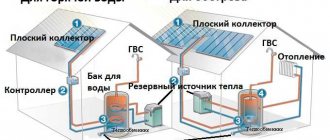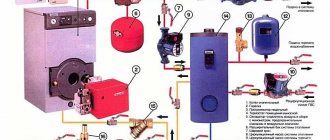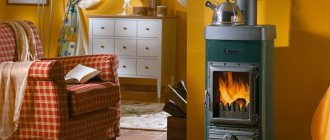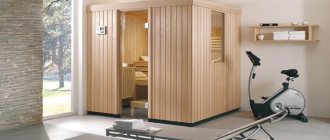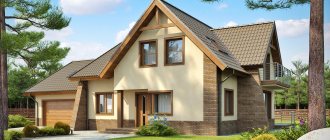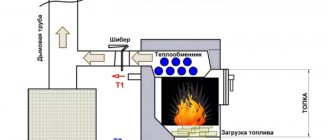Materials and tools used for constructing a two-story stove
To build the structure, you will need the same materials as for the construction of conventional heating or cooking stoves, with the only difference being that a two-story stove has a larger mass and height.
The structure will consist of the following main parts:
- Monolithic foundation;
- Masonry of the bottom, blower and combustion chamber;
- Masonry of chimney ducts;
- Exterior finishing;
- Views, dampers, oven and firebox doors, hob (if necessary);
- chimney;
- Deflector or canopy on the roof.
To build this structure you will need:
- Fireclay fire-resistant brick;
- Ceramic ordinary solid brick made of red clay;
- Fireclay clay or mixture for laying refractory bricks;
- Cleaned quarry sand;
- Cement-sand mixture;
- Cement grade 500;
- Furnace fittings - dampers, inspection doors, grates, combustion doors and ducts;
- Metal fittings – steel angle 50x50 or 60x60 mm;
- Sections of steel reinforcement with a diameter of 8 mm;
- Knitting wire;
- Asbestos sheet.
The tools that will be used are:
- Master OK;
- concrete mixer or solution container;
- buckets for transferring materials and supplying solution;
- power tools for preparing the solution;
- level;
- plumb line
The calculation of the required material is carried out based on the sequential masonry plan. When calculating, a reserve of 5% is made for the amount of fireclay bricks, 10% for red brick, and the same amount must be reserved for facing materials. The reserve for clay and cement mixture is made at least 15%. True, this applies to the case when the masonry is done independently.
Two-story oven with fireplace and hob
Functional model with one firebox and open fireplace on the first floor, and two decorative fireplaces on the second. The stove and fireplace are located on different sides and can operate simultaneously. The combination of gas flows begins above the fireplace damper. The design of the fireplace insert is simplified; there is no smoke tooth. There is a hob on the side, but no oven.
Cross-section of a two-level stove with a fireplace
Two-level model diagram
The principle of masonry and the movement of gases
The author of the order used modern techniques to increase efficiency and simplify operation. When using a fire door with glass, it is recommended to leave a through gap in front of the grate in the firebox floor. This trick prevents soot from forming on the door.
The order of masonry from 1 to 15 rows
Ordinal scheme from 16 to 26 rows
Laying walls from 27 to 42 rows
Construction requires 1000 pieces of fireclay bricks (highlighted in yellow in the diagram) and 1100 pieces of single solid red brick. The choice of refractory bricks for the construction of the walls of the stove and fireplace is based on the desire of the customer.
Important! Any finished arrangement of a stove on 2 floors requires modification, taking into account the characteristics of a particular house, its area, and ceiling height. Before purchasing materials, consult with an experienced stove maker
If necessary, he will make constructive changes to the circuit and give practical advice.
Before purchasing materials, consult with an experienced stove maker. If necessary, he will make constructive changes to the circuit and give practical advice.
744eab03586ee883b551923abc3fc0db.jpe
Selecting the optimal heating scheme
First, let's determine what type of heating system we need - with natural or forced circulation. If you have a large two-story cottage, then you definitely need to choose a system with a pump. But if you have a small dacha in an area remote from central highways, a gravity-flow system that can operate without electricity may be suitable for you.
When making a final decision, it is important to remember that most homeowners prefer a two-pipe scheme with a forced operating principle
Correct placement of the stove in the bathhouse
If we put all of the above together, we can come to the conclusion that the best option for installing the stove is to move it to a separate room - in this case, all the requirements will be met, and using the bathhouse will become as convenient and comfortable as possible.
Of course, one can make the erroneous conclusion that the sauna stove is installed in a very large room, and this design is only suitable for large baths designed for a large number of visitors. This is not true, because to install a sauna stove you can use a small opening between the functional sections of the sauna.
When choosing a suitable place to place the stove, you must take into account the layout of the entire structure and build on the steam room, washing area and dressing room so that they all receive their share of the heat. By carefully considering the situation and assessing all factors, you can achieve maximum efficiency of the stove, which will avoid the use of additional heat sources in the bathhouse.
Naturally, before placing the stove in a steam bath, you need to calculate the area required for installation. Provided a high-quality diagram of the entire bath building is created, it is possible to ensure that the stove takes up no more than 0.15 square meters of area - and this is quite a bit, so this option is good for small rooms.
However, in the absence of serious restrictions, you can safely increase the size of the area for the stove, and it will be much easier to manage both during sauna procedures and in other situations related to the operation of the sauna stove - during repairs and other maintenance.
Conclusion
The question of how to place a stove in a bathhouse is quite popular, and this article gives a comprehensive answer to it. When installing a stove, it is necessary to take into account the design features of the bathhouse, available resources and certain standards so that the bathing procedures are as comfortable and safe as possible.
For many centuries in Russia, the bathhouse had a sacred meaning. In the steam room, the body and soul are cleansed, rituals and sacraments are performed. The place where fire and water meet has brought down to this day a large number of pre-Christian traditions. When building a bathhouse, it is important not to miss a single detail: choose the “right” and suitable stove, room layout, materials for load-bearing structures, fire protection and finishing.
During the years of Soviet power, many traditions were forgotten. Private family baths have practically disappeared, and only public ones have survived. Some construction and heating technologies were lost, and now they are being restored through the joint efforts of specialists and lovers of light steam.
A three-room sauna stove is one of the most difficult to understand and hotly debated issues. The influence of the building design on the choice of furnace power does not give any room for error during design and construction. In this article we will talk about heating a bathhouse for 3 compartments with a stove and the features of the layout of the premises.
Features of designing houses with stove heating
Central placement
As already mentioned, one of the most acceptable options for installing a stove in a house where a water circuit is not used for heating is central placement. The most common way is to make the stove become a single point for all adjacent rooms. In such cases, the hearth is installed in the wall between the rooms, and the firebox is installed either in the kitchen or in the corridor.
Multiple heat sources
Another option that is offered to those who want to get a house with stove heating is the creation of several heat sources. The disadvantage of the idea is that each of them will need to be heated separately and, accordingly, more fuel will be spent to heat the premises. Centralized placement of the stove solves the problem much more effectively.
Sword size
Another nuance that is not taken into account by many customers who want to build their home with stove heating is the size of the stove. There is often a misconception that the larger the stove, the more heat you can get from it, and the more efficient it will be. On the one hand, this is indeed true. However, you must understand that the larger the stove, the more difficult it will be to heat it to the required temperature. At the same time, it will spend much more fuel than a small one.
The optimal solution in this situation is to build a small stove, but of a design that will allow you to retain heat longer and lose less heat. Then heating will be more affordable.
Two-storey house
If you have to deal with a two-story house that uses stove heating, then a different approach is applicable here. A special stove system is installed, when the lower part has all the necessary attributes - a stove bench, a hob and an oven - and on the second floor only a heating panel is used. Such a house requires very durable materials and precise calculations so that the brick structure on the second floor does not lead to damage to the house.
Some oven designs can be designed so that only the cooking portion is used. In this case, heating is not produced, which is very convenient in the warm season.
What size house can be heated with a brick stove with a water circuit?
A brick stove can also be adapted for heating large areas if, when building it, a heat exchange element is placed near the firebox through which the coolant will pass, heating up and then circulating in the heating system distributed throughout the house. In this case, you may need to connect a water pump, which will accelerate the movement of coolant in the system.
Homemade efficient heat exchanger
Heat exchange elements can be of different shapes; the photo shows one of them. It is embedded in the structure of the stove near the combustion chamber so that, passing through it, the water quickly heats up and enters the pipes and radiators.
The inlet and outlet pipes from the heat exchanger are led outside the furnace structure, and the heating circuit is connected to them. Next, the system is filled with water, which will act as a coolant.
Wiring can be done using metal-plastic or polypropylene pipes
In this case, metal-plastic pipes are used for wiring and connection to the circuit.
Diagram of a wood stove with a water heating circuit
In this diagram, the heat exchanger is located above the firebox and is shown as a red grate. The blue line marks the cooled coolant, which passes through the circulation pump and enters the heat exchanger - this part of the circuit is called return. The red line marks the heated water entering the radiators.
A membrane tank is also installed in the heating circuit, which can be located in any accessible location in the circuit, but it is advisable to install it on the return pipe.
It is also called a closed expansion tank. There is a nipple on its upper part, through which air is pumped into the upper chamber. When water in the system heats up, it expands and excess water rises into the tank, stretching the membrane. When cooling and the corresponding pressure drop, water is pressed back into the system. In this way, possible pressure surges in the pipes are smoothed out, and the risk of destruction of the integrity of the system from overheating is minimized.
Video sketch: an interesting version of a fireplace stove with a heating circuit
Neoclassical
Even popular music has echoes of ancient motifs. The same can be said about the design, in which classic details are framed in a fashionable design.
This style is characterized by symmetrical lines, framed mirrors, arched openings, and antique accents. All this is complemented by fashionable finishing materials and accessories. Neoclassicism combines sleek modern details with traditional combinations.
Natural circulation scheme
To understand the principle of operation of the gravity system, study the typical diagram used in two-story private houses. Combined wiring is implemented here: the supply and return of coolant occurs through two horizontal lines, connected by single-pipe vertical risers with radiators.
How gravity heating of a two-story house works:
- The specific gravity of the water heated by the boiler becomes smaller. The colder and heavier coolant begins to displace hot water upward and take its place in the heat exchanger.
- The heated coolant moves along a vertical collector and is distributed along horizontal lines laid with a slope towards the radiators. The current speed is low - about 0.1-0.2 m/s.
- Dividing through the risers, the water enters the radiators, where it successfully releases heat and cools. Under the influence of gravity, it returns to the boiler through a return manifold, which collects coolant from the remaining risers.
- The increase in water volume is compensated by an expansion tank installed at the highest point. Typically, the insulated container is located in the attic of the building.
Schematic diagram of gravity distribution with a circulation pump
In modern designs, gravity systems are equipped with pumps that accelerate circulation and heating of rooms. The pumping unit is placed on a bypass parallel to the supply line and operates when electricity is available. When the light is turned off, the pump is inactive, and the coolant circulates due to gravity.
Scope of application and disadvantages of gravity feeding
The purpose of the gravity circuit is to supply heat to homes without connection to electricity, which is important in remote regions with frequent power outages. The network of gravity pipelines and batteries can work together with any energy-independent boiler or stove (previously they said steam) heating.
Let's look at the negative aspects of using gravity:
- due to the low flow rate, it is necessary to increase the coolant flow by using large-diameter pipes, otherwise the radiators will not warm up;
- in order to “spur” natural circulation, horizontal sections are laid with a slope of 2-3 mm per 1 m of the highway;
- healthy pipes running under the ceiling of the second floor and above the floor of the first floor spoil the appearance of the rooms, which is noticeable in the photo;
- automatic control of air temperature is difficult - for batteries you need to buy only full-bore thermostatic valves that do not interfere with the convective circulation of the coolant;
- the scheme is unable to work with heated floors in a 3-story building;
- An increased volume of water in the heating network implies prolonged heating and high fuel consumption.
To fulfill requirement No. 1 (see the first section) in conditions of unreliable power supply, the owner of a two-story private house will have to bear the costs of materials - pipes of increased diameter and cladding for the manufacture of decorative boxes. The remaining disadvantages are not critical - slow heating is eliminated by installing a circulation pump, lack of efficiency - by installing special thermal heads on radiators and insulating pipes.
Design Tips
If you have taken the development of a gravity heating scheme into your own hands, be sure to consider the following recommendations:
- The minimum diameter of the vertical section coming from the boiler is 50 mm (meaning the internal size of the nominal diameter of the pipe).
- The horizontal distributing and collecting manifold can be reduced to 40 mm, before the last batteries - to 32 mm.
- A slope of 2-3 mm per 1 linear line of the pipeline is made towards the radiators on the supply and the boiler on the return.
- The inlet pipe of the heat generator should be located below the radiators on the first floor, taking into account the slope of the return line. It may be necessary to make a small pit in the boiler room to install a heat source.
- On the connections to heating devices on the second floor, it is better to install a direct bypass of small diameter (15 mm).
- Try to place the upper distribution manifold in the attic so as not to run under the ceilings of the rooms.
- Use an open-type expansion tank with an overflow pipe leading outside and not into the sewer. This makes it easier to monitor when the container is overfilled. The system will not work with a membrane tank.
The calculation and design of gravity heating in a cottage with a complex layout should be entrusted to specialists. And lastly: lines Ø50 mm or more will have to be made of steel pipes, copper or cross-linked polyethylene. The maximum size of metal-plastic is 40 mm, and the diameter of polypropylene will be simply menacing due to the thickness of the walls.
Air heating
In this category we include all methods of heating without the mediation of a coolant - water, oil, antifreeze and any others. The air in the room is heated through direct contact with the heating element.
Buleryan
The stove is a firebox surrounded by thick pipes with open ends up and down. The pipes heat up and provide convective mixing of the air in the room.
Directing them in different directions speeds up the process. If it is necessary to heat several isolated rooms from the buleryan, air ducts with natural or forced circulation are installed.
Advantages:
- Existing furnaces ensure almost complete combustion of fuel due to the fact that they provide long-term smoldering with a limited supply of oxygen. This ensures efficiency that is unattainable for traditional stoves.
- Buleryan does not take up much space and does not require its own premises. A stove for heating two floors can easily fit in the living room or dining room. There will be no soot or odors.
- Installing air ducts will cost less than installing a water heating system. Although, taking into account the necessary thermal insulation, not by much.
Flaws:
- It is almost impossible to lay air ducts after finishing the final renovation without spoiling the aesthetics of the room. The heating plan for a two-story house - both the heat source and the wiring - will have to be thought out in advance.
- Any stove heating of a two-story house is associated with the need to store reserves of firewood, coal, pellets or peat briquettes.
In the photo there is a buleryan stove in the living room.
Brick oven
An ordinary Russian stove usually has very impressive dimensions.
It occupies up to a third of the house’s area and is quite capable of heating several rooms. It is clear, however, that two-story heating stoves are somewhat more complex structures.
In general, there are almost no standards in the field of designing brick kilns. The specific implementation depends on the size of the room, the location of the stove, the imagination of the stove maker, or, alternatively, the order of a ready-made solution found on the Internet that was invented by someone else.
A typical two-story heating stove has a firebox located below and a cap or duct chimney that makes several turns on the second floor.
Execution options can be varied. For example, it is enough to place a cast-iron stove on the firebox, laying an asbestos cord under it to isolate the room from combustion products - and you will get a heating and cooking stove on two floors.
The stove can be placed in the middle of the room or in the corner; finally, if desired, you can even organize water heating of a two-story house with natural circulation by simply placing a coil in the firebox.
Dignity:
In the absence of gas, stove heating is the cheapest heating method. A brick stove pleases its owners with its great thermal inertia: it is usually heated once a day for 2-3 hours, and the rest of the time it releases the accumulated heat.
Flaws:
- Again, you will need a supply of fuel, which will take up a fair amount of space in the yard.
- Folding a stove so that condensation does not seep through the masonry, so that the stove does not crack and smoke into the room is an art that is gradually being lost.
If you are not afraid of experiments, you can try to do this work yourself; but in the absence of any experience, it is better to be prepared for various surprises.
Gas convectors
Another way in which you can do air heating of a private two-story house with minimal time and money is by installing gas convectors.
Each device is a closed burner with air intake from the street and combustion products discharged there through a coaxial pipe. The heat exchanger heats the air in the room. The devices can operate from both main gas and bottled gas.
2163d27d9b0f7a448f842769831b5843.jpe 6abc3571ae8d0fcb3349ee3d83cd8e79.jpe 70d1ae7f8983b60d60e7b2d69c801397.jpe 81fa333c2bc668042adc3 d10b0c088ea.jpe
Advantages:
- Full autonomy of heating for each room in the house.
- Low project cost. The price of each convector is 4-8 thousand rubles. Considering that you do not need a boiler and wiring from it, this will mean significant savings.
Flaws:
- Unfortunately, mains gas is not available everywhere.
- Installation of convectors is possible only on the external wall of the house.
- Drilling wide holes for a coaxial pipe in, for example, reinforced concrete is still a pleasure.
- look here.
Stoves on two floors
The main task of the stove maker when constructing a two-story stove is to, taking into account the characteristics of the room, distribute the heat in such a way that it will not be too hot on the first floor and not too cold on the second. When calculating the stove, you need to remember that warm air rises, which means that heating the second floor requires less heat than the first. Based on this, on the first floor you should not get carried away with the long length of the channels, but it is better to save them for the second floor. If the room on the second floor is not large, then a cap that accumulates heat after passing through the channels of the first floor will be quite sufficient for heating.
Double-deck furnaces should not be equipped with horizontal channels, as this significantly slows down the speed of gas movement, and therefore contributes to increased soot formation. If the smoke channels are excessively long, the temperature of the gases at the outlet of the pipe may drop below 100ᴼ C, which will inevitably lead to the formation of condensation.
The second floor stove must rest entirely on the first floor stove; it is strictly forbidden to place the second floor stove on wooden floor beams, since a wooden house will shrink over time and will tear the masonry at the junction of the stoves. Two-story brick stoves must be equipped with a direct stroke valve to facilitate ignition after a long break between fireboxes. If the design does not allow for a direct stroke valve, you can pre-ignite the furnace through the last cleaning door.
Is stove heating possible in an apartment building? Yes, the designs of furnaces make it possible to heat even fairly large buildings, if they are no more than two floors in height. There are several options for arranging the heating of two-story buildings, and, despite the new types of equipment that have appeared, stove heating is not losing ground. The stove can be used as a hob, as a fireplace, and as a regular solid fuel boiler, if it is equipped with an additional water circuit.
How does stove heating work in a two-story house?
Any stove is heavy, so it should be located next to solid internal walls, which will make it possible to balance its operation. If the total estimated weight of the stove is no more than 700 kilograms, then it can be installed directly on the floor, but only if it initially has high strength. If the total weight of the stove is too large, then it becomes necessary to lay a foundation. The foundation must be laid to a depth of at least one meter.
If stove heating in the house is the main one, then a separate stove must be installed on each floor. In general, it would be best to design and calculate the stove masonry before building the house. A stove installed on the second floor should be located directly above the stove, which is located on the floor below. This is done to reduce the load on the floor between floors. In addition, reinforced concrete slabs are often used to provide greater reliability and rigidity.
Features of a heating stove on two floors
It is important to know exactly what the weight of the future heating system will be. To build a reliable structure, it is necessary to pour the foundation
It must be deepened into the ground by at least 1 meter, and the ceiling between the first and second floors must be very strong. A reinforced concrete slab can support this weight. Installation of such structures should be carried out along internal load-bearing walls.
A two-story stove can be of two types - a stove with one firebox or with two. The main firebox in such structures can only be on the ground floor, as well as all heavy extensions - a stove bench or stove. A fireplace may be installed on the second floor - sometimes false, but more often functional. A false design will increase the heat transfer of the heating system, and the current one will allow you to warm up the room faster. Such systems include two-channel chimneys.
Stove with one firebox
A heating system with one firebox may last less than two fireboxes. This happens due to the specific design of the system itself.
On the top floor there should always be channels located vertically. In order to separate the heating of the floors, dampers are installed.
Their function is to block the movement of flue gases. After this, the cooling gases in the chimneys of the second floor form condensate. thus, the masonry begins to gradually collapse. The design of a stove in the house with two fireboxes can provide faster heating.
On average, the size of the firebox of such a stove is designed for a single loading of up to 50 kg of dry firewood. Typically, for stoves with one firebox, the logs are stacked vertically. This allows for faster heat transfer. The gases rise up the first ascending chimney, then, at a height of about 3 meters, the gases are separated into the distribution chimneys of the first or second floor. There may be bricks protruding inward inside the vertical channels. They allow you to increase the surface area that absorbs heat.
In places where there may be an accumulation of soot or ash deposition, special openings for cleaning should be provided, but closed with doors. A heating system with a single firebox has a big advantage. You only need to heat on the first floor. No need to carry firewood upstairs and do the same thing twice.
Fireplace design
Such structures are very similar to a fireplace from the outside, but inside they have the same number of smoke circulation channels as in a stove. Combining a fireplace and stove is not something new. This hybrid design has been used in everyday life for quite some time. Its main difference is that it is able to retain heat in the house for 18 and even 24 hours. The heat transfer in such furnaces can reach 5 kW, which is twice as much as in conventional units, and this figure allows you to save on fuel. This result can be achieved by using fireclay bricks in masonry. There are smoke channels on three sides of the firebox, which allow the surface to be heated evenly.
As a rule, a fireplace stove takes up much less space in the house. than the classic one, and visually this design looks quite attractive.
But when choosing such a system in your home, it is important to understand that installation and material costs may be more expensive due to the firebox doors - which can be made using fire-resistant glass, or due to the design idea. Very often, a stove is located above the firebox, presented in this building as a fireplace.
It is very convenient to bake here, but unfortunately, in this design the heating system is the main one, so there is no hob here
Very often, a stove is located above the firebox, represented in this building as a fireplace. It is very convenient to bake here, but unfortunately, in this design the heating system is the main one, so a hob is not provided here.
Stove heating of this type for a two-story house, although it has advantages in heat accumulation compared to others, still will not provide as much heat on the second floor as on the first. It is better not to build such a structure yourself, but to entrust it to professionals.
Stove heating for a two-story house located outside the city or in the countryside may be the only possible option. The high cost of electricity and frequent interruptions cannot provide inexpensive and efficient heating in the house. The use of natural gas is also not always possible, because access to it is not available everywhere, and using propane in cylinders for heating is not profitable and may be unsafe.
Positive and negative aspects of stove heating in a private house
In most cases, stove heating is installed if necessary, in the absence of main natural gas. But heating with a stove has its advantages and disadvantages, which it would also be nice to know about.
What are the disadvantages?
Negative points include:
- It takes quite a long time to heat up the stove, and therefore the premises. This occurs due to prolonged heating of the walls and coolant in the system.
- Not very high efficiency of a brick building. To increase it, you have to build a higher chimney, make it a labyrinth type, so that the heat remains inside the structure longer.
- A brick stove occupies a fairly large area, but only on such a scale is it capable of heating several rooms at the same time.
- Unlike heating with natural gas, the stove must be supervised throughout its entire combustion, since brick options require constant addition of fuel. Long-burning cast iron stoves are an exception, since firewood is added once per burning session.
Positive points
Stove heating also has many positive qualities, which are often decisive in choosing it for installation in a private home.
- Autonomy, which means reliability. The house will always be heated, even if the electricity and water are turned off.
- Affordability of construction and operation of the structure.
- Cost-effectiveness in purchasing fuel and no bills for the main gas or hot water supply, which, unfortunately,
- Easy to operate - the oven does not require programming, and if problems arise, they can be eliminated independently, without the involvement of specialists.
- Since the stove does not require communications for its operation, it can be installed or erected in a house located in any region and locality.
Projects of houses with a Russian stove
The size of the stove largely depends on the planned size of the house itself and the purposes for which it will be used. Therefore, it is worth deciding in advance on the main functionality that you plan to provide to the house. Now we will look at one-story house designs with a Russian stove.
5x6 meters
Such a small house is suitable only for temporary stay. An example of such a structure is shown in the picture below. Such a log house does not require a large furnace, and it is more profitable to install it as an object for zoning the adjacent territory.
In this case, it is much more effective to leave the rooms without division, then the heat will be evenly distributed to the necessary places and will not be retained by the walls.
6x6 meters
Such a layout can be made for, again, a small country house, where you can move in in the summer, and when frost sets in, go home. At the same time, you can build the same small stove for heating and cooking. It is not necessary to make a bed for it if you can get by with a Europeanized version of the stove.
6x9 meters
When you plan to build a house in which a small family can live almost all year round, you should think in advance about the heating system. In many regions of Russia, using electricity for heating in cold winter will lead to high electricity bills. However, not all areas have access to gas. Plus, it will require special permission. Thus, the classic Russian stove becomes one of the saving heating options.
7x7 meters
This is a more spacious house that will require much more heat. To live in this all year round, some people want to install diesel heating. However, to implement this idea, it will be necessary to create a special storage facility that will contain at least 3 tons of diesel fuel. At the same time, a properly built stove will help provide the house with the necessary level of heat, and no room will remain cold.
8x8 meters
This method of construction is usually used for a square cottage, only larger than a building with dimensions of 6x6. In both cases, the most optimal solution is to build the house so that the stove is located in the very center of the structure. With this layout, you can count on the fact that the stove will be able to evenly heat all the rooms adjacent to it. The most important thing in houses with a large area is not to place the stove next to the wall, as this will lead to heat transfer towards the street, and not towards the living rooms. This is an excellent house project with a Russian stove with a stove bench.
9x12 meters
Layout of a house with a Russian stove 9x12 meters. This type of building can include, for example, a covered and insulated terrace. In the example below, without taking it into account, the area of the house turns into a standard square, only with sides of 9x9 meters. In this case, you can simply go the same way as in other square houses, since terraces are usually not used as living spaces, but serve for a pleasant time in the summer.
Main characteristics of home heating stoves
The main characteristics of home heating stoves that need to be taken into account when choosing a design are heat capacity and cooling time.
Active volume
- a quantity characterizing the volume of the furnace mass, which is heated during the combustion process (including the voids of the structure). Its value is determined by the product of the calculated (active) height of the furnace and the area of the lower level of the firebox. The active height in the calculations is taken to be from the bottom of the firebox (or the bottom of the flood channel located below) to the upper (if the thickness of the ceiling is less than 14 cm) or lower (14 cm) plane of the ceiling. If the active volume is 0.2 m3 or more, then such furnaces are classified as heat-intensive; if less than the specified value, they are classified as non-heat-intensive.
Based on the temperature of the heat-releasing surface of the furnace, they are divided into:
- moderate heating (those with a wall thickness of 12 cm or more are heated to 90 °C);
- increased heating (those with a flue wall thickness of up to 7 cm are heated to 110-120 °C);
- high heating (surface heating temperature is not limited).
Depending on the movement of flue gases, furnaces can have the following schemes:
- flue gases move through channels connected in series: single-turn - with one lifting channel, double-turn - with two lifting channels;
- flue gases move through channels connected in parallel: single-turn, double-turn;
- flue gases move freely: ductless (bell-type);
- flue gases move through a combined system of channels with bottom heating: with a channelless overhead part, parallel, sequential;
- flue gases move through channels connected in series around the hot-air chambers.
Classification of stoves by type of finish and solid material in descending order of heat capacity: brick tile; brick and metal in cases; brick plastered; steel with an internal lining of refractory bricks; concrete made of heat-resistant blocks; cast iron without lining.
Flue gases in furnaces can be discharged:
- through root and mounted chimneys;
- through internal channels.
In-wall smoke ducts are laid in the brickwork of the building. The furnaces are connected to them with metal pipes placed horizontally. The length of these pipes should not exceed 40 cm. Mounted pipes are located above the stoves. Sometimes the main pipes are laid on independent foundations.
According to their functional purpose, furnaces are divided into the following types:
- heating;
- household;
- special;
- heating and cooking;
- heating stoves;
- combined.
It is desirable that the selected design has a high coefficient of efficiency (COP), warms up well over the entire surface and releases heat evenly throughout the day. The stove must be simple, technologically advanced, reliable in operation and safe.
The heat generated by the stove must correspond to the heat loss of the room. In this case, the air temperature in the room will always remain at the desired level.
